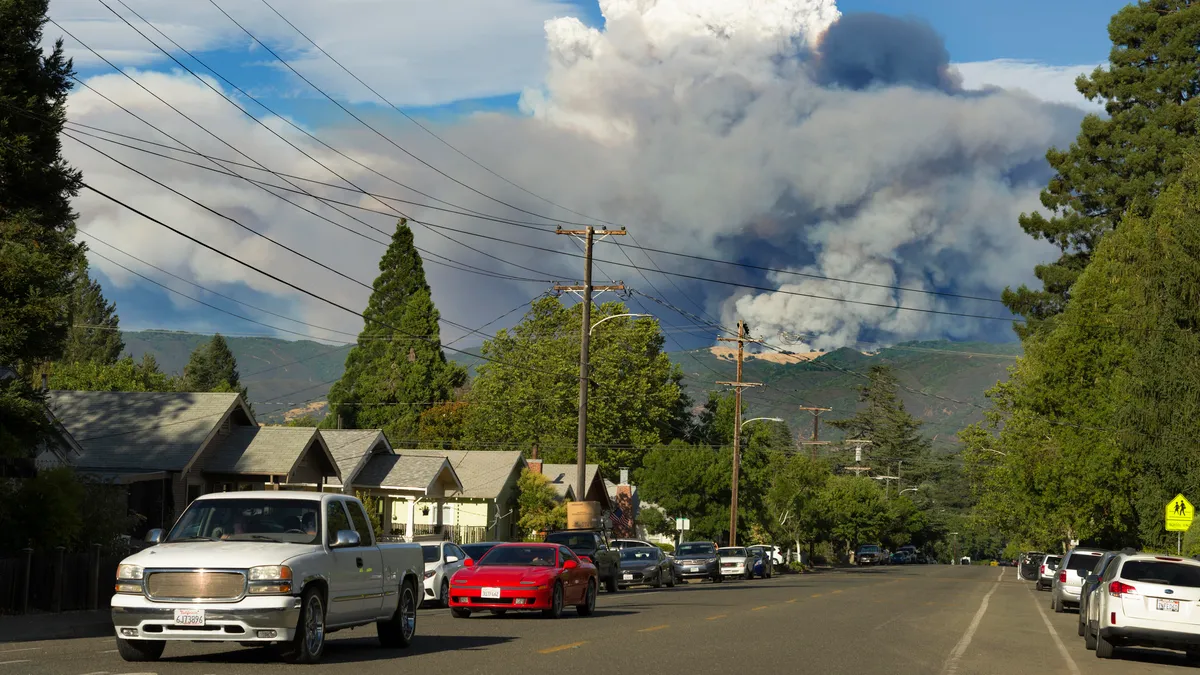Dive Brief:
- Pacific Gas & Electric discovered more than 100 instances of "damage or hazards" during an inspection of its system following the Oct. 9 Public Safety Power Shutoff (PSPS), including dozens of spots the utility says could have ignited a wildfire had equipment remained energized.
- New details about system damage were revealed in an Oct. 30 filing with the U.S. District Court for the Northern District of California. The multi-day blackout impacted 2 million people and PG&E was widely criticized for poor communication and coordination before the event and during recovery.
- Since the early October event PG&E has cut power multiple times when high winds raise wildfire risks. A new analysis from Moody's Investor Service warns of potential "reputational damage" utilities could face related to the shutoffs — which in turn, could hurt credit scores.
Dive Insight:
Many agree the Oct. 9 shutoff was poorly handled. PG&E's web site crashed multiple times and incorrect information went out to customers and local officials. The utility vowed to make improvements to the process, but also maintains the shutoffs are necessary and effective.
"We can't prove our decision avoided wildfires that otherwise would have occurred," PG&E CEO Bill Johnson told the California Public Utilities Commission on Oct. 18. But new information submitted to the district court appears to make the case.
In total, the utility's post-event inspection found 115 instance of damage, including 74 instances of vegetation damage and 41 instances where damage to infrastructure appeared to have "been caused by extreme wind and/or other fire conditions."
The utility told Judge William Alsup that "44 instances of vegetation damage likely would have caused arcing if the lines had been energized based on PG&E’s assessment." And another 12 instances where damage did not involve vegetation also "likely would have caused arcing."
In more than a half dozen instances, the utility said it was unable to make a determination.
Of the 44 instances where vegetation damage could have caused arcing, or unintentional electric discharge known to spark fires, more than 40% (19) occurred in Santa Cruz or Santa Clara counties, according to supplemental information PG&E supplied to the court.
PG&E says that the overall damages were spread widely across its system.
"The sole focus of a [PSPS] event is to keep our customers and communities safe from the threat of wildfire," PG&E told Utility Dive in an emailed statement. Of more than 100 instances of damage or hazards found, "it is possible that many of these instances could have been a potential source of ignition had a PSPS not been initiated."
Power shutoffs could add credit risk, says Moody's
PG&E's territory is most at-risk from wildfires, but all of the state's utilities are dealing with the issue and a new assessment from Moody's concludes power shutoffs can have unanticipated ramifications.
The PSPS program may be effective risk reduction, "but use of power shutoffs will raise other social risks for utilities," said Moody's.
"The longer the shutoffs and higher the associated costs to customers, the greater the potential reputational damage faced by the utilities. Reputational damage can hurt credit quality because it can contribute to a more contentious relationship with regulatory authorities," the ratings agency said.
Of California's big three IOUs, Moody's said San Diego Gas & Electric "has the most advanced wildfire risk mitigation infrastructure and experience with PSPS" due to steps it took following wildfires in its territory more than a decade ago.
"At the other end of the scale is PG&E, whose vast service territory includes heavily wooded areas that are difficult to protect from wildfires," said Moody's.

PG&E is working to make its system more resilient, but officials say the work will take years.
In the meantime, Moody's has a bleak outlook on wildfires' potential to impact utility credit.
"Environmental risk remains high, as the effect of climate change manifests itself in higher water and heat stress. Over the coming years, wildfire risk is likely to get worse and will drive changes in social risk," the firm said. "Governance considerations are also rising in prominence, as we see differences in how utility companies maintain their infrastructure."
All of this increases the vulnerability of a utility's system and "the risk of significant reconstruction costs," the ratings agency said.















